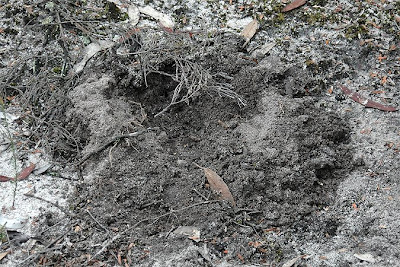Anyway, this little Echidna (I would estimate it as 3/4 sized individual) I found in the bush along Meryla Pass Road. The soil was very loose, grey sandy soil, in heathland shrubbery, under Scribbly Gums, over a sandstone rock shelf. There were lots of nests of small ants, which probably explains why it was there.
Nose marks of Echidna, poking into ants nest.
Echidnas have very powerful legs, especially their front legs, with which they do most of their digging. This little guy clearly did not want me to disturb it, and I agreed. They have a very wide flat tail, and that is quite muscular as well, and the flap of its tail was tucked down very tight into the soil, to prevent me trying to do the bushman's favourite trick of lifting them up by the back legs. So, I left it in peace and kept on exploring for Orchids and other interesting things.
I was very surprised to come around a patch of low heath-type shrubbery and suddenly find the back of the Echidna sticking out of the loose sandy soil. Clearly the animal had heard me coming, and burrowed its head into the soil. Naturally I gave it a little prod, which produced a response of it wriggling further into the soil.

On my way back to the car, I found "another Echidna". A quick check of the original spot showed the marks where the Echidna had originally burrowed in - but it was no longer there.
Marks where the Echidna had first burrowed in.

Clearly I had found the same Echidna twice. It was doing exactly the same thing as before, but ina slightly different location.
Suddenly it lifted its head, to see if I was still there. I was! Thanks for the photo opportunity - about 3 seconds worth.

On a closer view, you can make out its long thin snout (where its long tongue is housed) with tiny nose holes on top. (Click on image, to see it more clearly).
 And the verdict? It still didn't want to know anything about me. Time for me to leave it alone.
And the verdict? It still didn't want to know anything about me. Time for me to leave it alone. You can clearly see where the tail is located, from the different shape and angle and colour of the spines at the rear. A set of long, white spines poke out in a radiating pattern from the rear of the animal. Those spines are protecting its flat tail.
You can clearly see where the tail is located, from the different shape and angle and colour of the spines at the rear. A set of long, white spines poke out in a radiating pattern from the rear of the animal. Those spines are protecting its flat tail.There is an Echidna research project (Australia wide) being conducted by a researcher on Kangaroo Island, South Australia. According to the information there, Echidnas have been around for 110 million years. They apparently survived, when the dinosaurs died out. Not a bad effort!
You can even fill in an Echidna Watch Form. I have done so, and I will post the form off.

1 comment:
Denis
I was thrilled just looking at your pics it must have been great to see both the echidna and the Helmet orchid. Good luck with the SCA.
Toni
Post a Comment